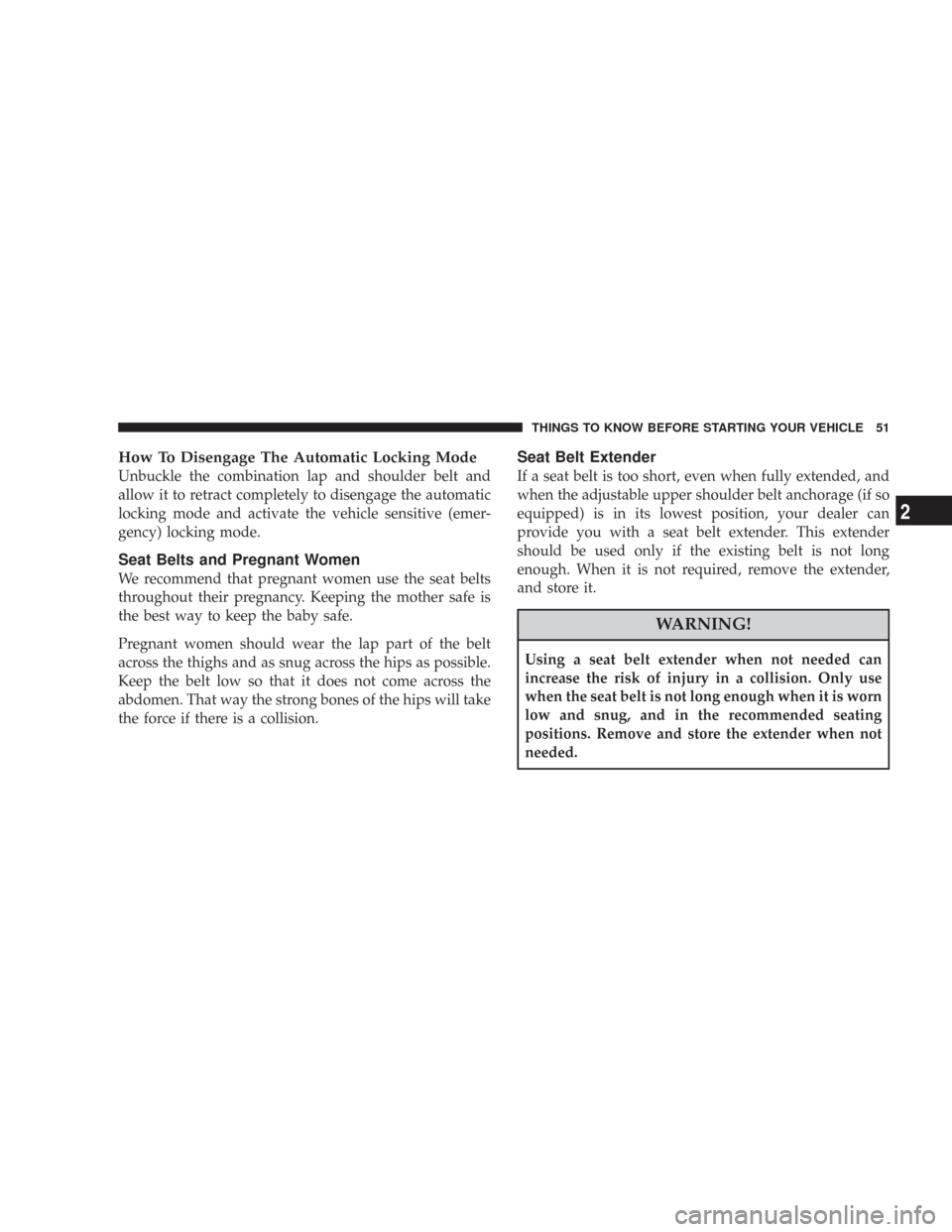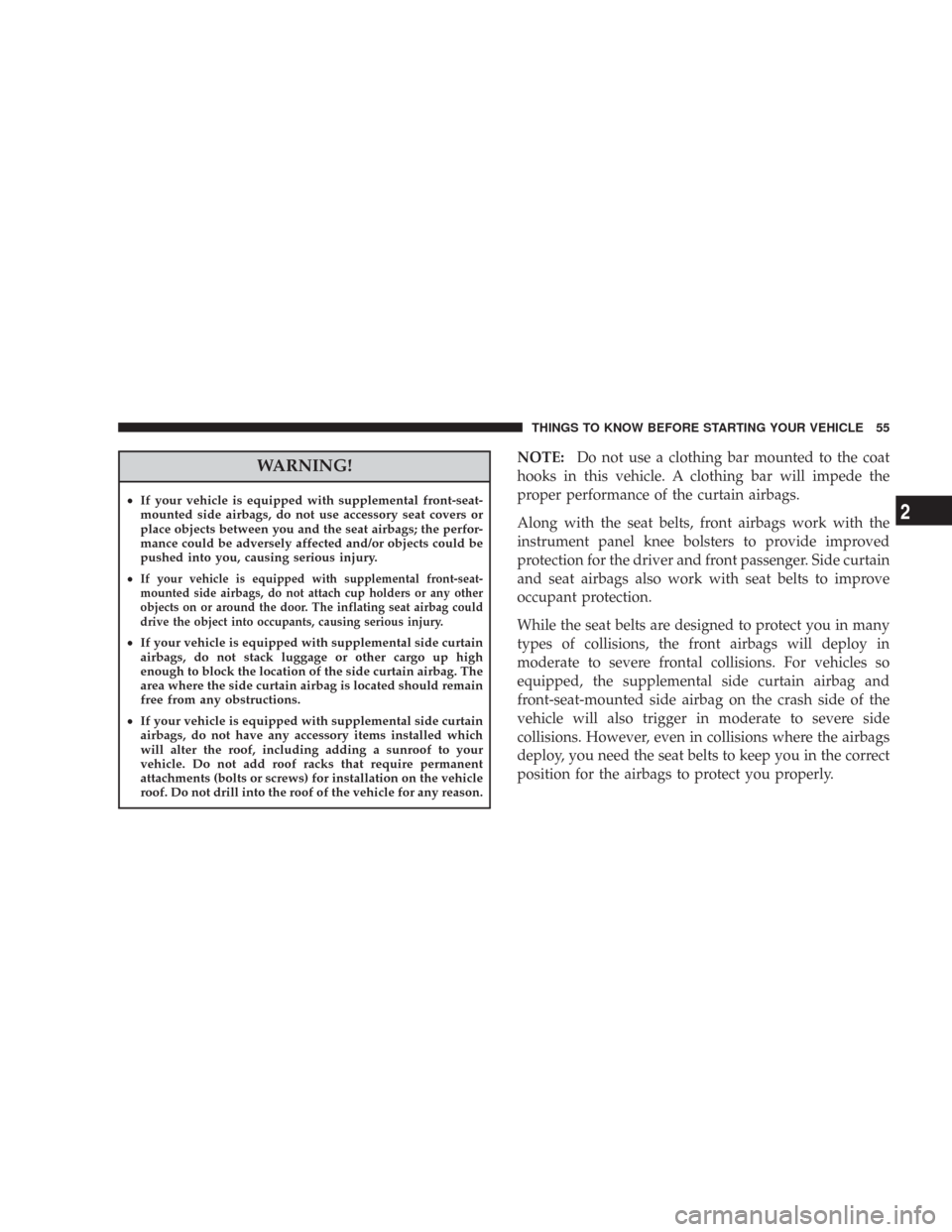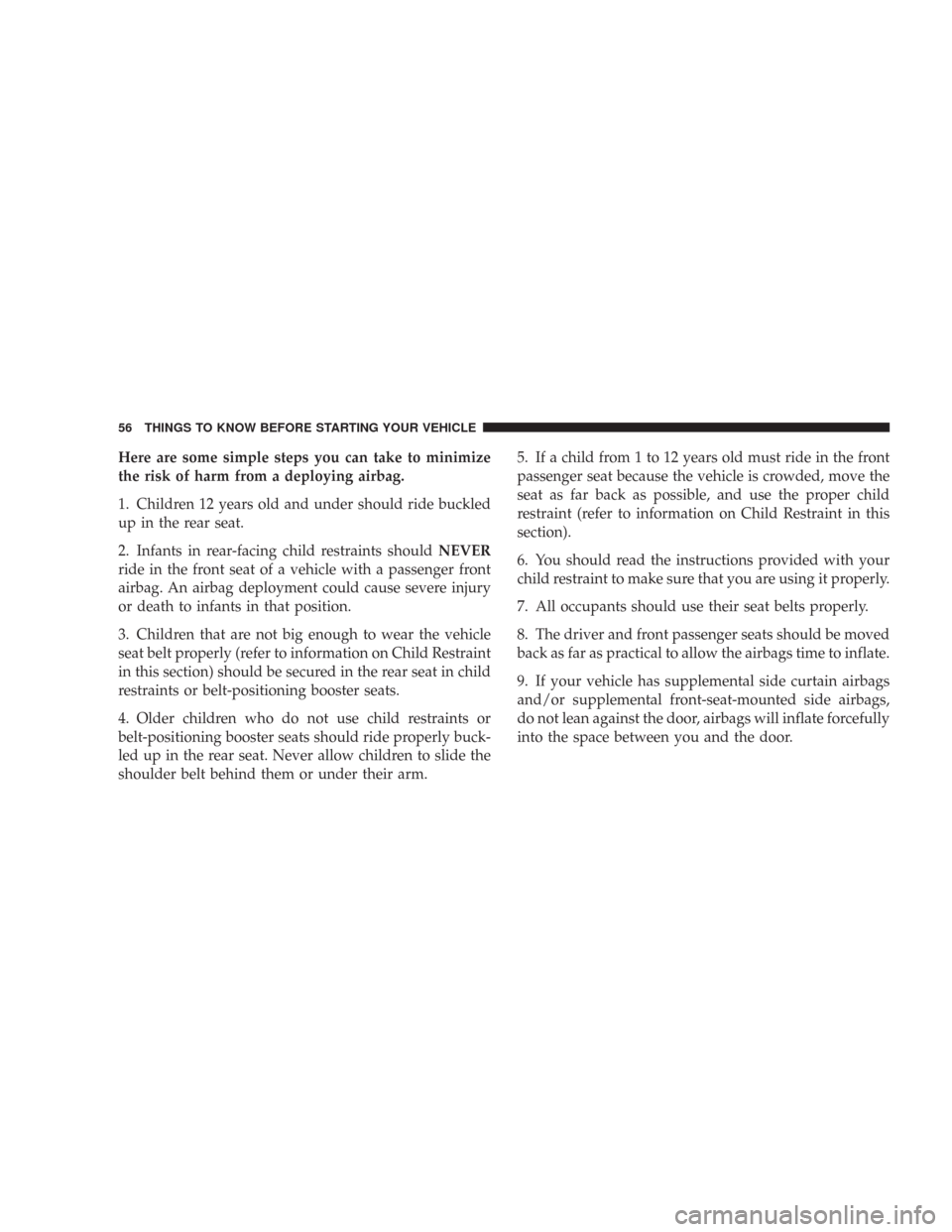Page 49 of 519

Enhanced Seat Belt Reminder System (BeltAlert�)
If the driver’s seat belt has not been buckled within 60
seconds of starting the vehicle and if the vehicle speed is
greater than 5 mph (8 km/h), the Enhanced Warning
System (BeltAlert�) will alert the driver to buckle their
seat belt. The driver should also instruct all other occu-
pants to buckle their seat belts. Once the warning is
triggered, the Enhanced Warning System (BeltAlert�)
will continue to chime and flash the Seat Belt Reminder
Light for 96 seconds or until the driver’s seat belt is
buckled. The Enhanced Warning System (BeltAlert�) will
be reactivated if the driver’s seat belt is unbuckled for
more than 10 seconds and the vehicle speed is greater
than 5 mph (8 km/h).
BeltAlert�Programming
The Enhanced Warning System (BeltAlert�) can be en-
abled or disabled by your authorized dealer or by
performing the following steps:NOTE:DaimlerChrysler does not recommend deacti-
vating the Enhanced Warning System (BeltAlert�).
1. With all doors closed, and the ignition switch in any
position except ON or START, buckle the driver’s seat
belt.
2. Turn the ignition switch to the ON position, but do not
start the engine. Wait for the Seat Belt Reminder Light to
turn off and then proceed to the next step.
NOTE:You must perform the following steps within 60
seconds of turning the ignition switch to the ON position.
3. Within 60 seconds of turning the ignition switch to the
ON position, unbuckle and then re-buckle the driver’s
seat belt at least three times within 10 seconds, ending
with the seat belt buckled.
THINGS TO KNOW BEFORE STARTING YOUR VEHICLE 49
2
Page 50 of 519

NOTE:Watch for the Seat Belt Reminder Light to turn
on while unbuckling the seat belt and turn off while
re-buckling the seat belt. It may be necessary to retract
the seat belt.
4. Turn the ignition switch to the LOCK position. A
single chime will sound to signify that you have success-
fully completed the programming.
The Enhanced Warning System (BeltAlert�) can be reac-
tivated by repeating this procedure.
NOTE:When the Enhanced Warning System
(BeltAlert�) is deactivated, the Seat Belt Reminder Light
will continue to illuminate as long as the driver’s seat belt
is unbuckled.Automatic Locking Mode — If Equipped
In this mode, the shoulder belt is automatically pre-
locked. However, the belt will still retract to remove slack
in the shoulder belt. Use The Automatic Locking Mode
any time a child safety seat is installed in a seating
position that has a seat belt with this feature. Seat belts
that have the Automatic Locking Mode feature have a
distinctive label on the webbing. Children 12 years old
and under should be properly restrained in the rear seat
whenever possible.
How To Engage The Automatic Locking Mode
1. Buckle the combination lap and shoulder belt.
2. Grasp the shoulder portion and pull downward until
the entire belt is extracted.
3. Allow the belt to retract. As the belt retracts, you will
here a clicking sound. This indicates the safety belt is
now in the automatic locking mode.
50 THINGS TO KNOW BEFORE STARTING YOUR VEHICLE
Page 51 of 519

How To Disengage The Automatic Locking Mode
Unbuckle the combination lap and shoulder belt and
allow it to retract completely to disengage the automatic
locking mode and activate the vehicle sensitive (emer-
gency) locking mode.
Seat Belts and Pregnant Women
We recommend that pregnant women use the seat belts
throughout their pregnancy. Keeping the mother safe is
the best way to keep the baby safe.
Pregnant women should wear the lap part of the belt
across the thighs and as snug across the hips as possible.
Keep the belt low so that it does not come across the
abdomen. That way the strong bones of the hips will take
the force if there is a collision.
Seat Belt Extender
If a seat belt is too short, even when fully extended, and
when the adjustable upper shoulder belt anchorage (if so
equipped) is in its lowest position, your dealer can
provide you with a seat belt extender. This extender
should be used only if the existing belt is not long
enough. When it is not required, remove the extender,
and store it.
WARNING!
Using a seat belt extender when not needed can
increase the risk of injury in a collision. Only use
when the seat belt is not long enough when it is worn
low and snug, and in the recommended seating
positions. Remove and store the extender when not
needed.
THINGS TO KNOW BEFORE STARTING YOUR VEHICLE 51
2
Page 52 of 519
Driver and Front Passenger Supplemental
Restraint System (SRS) - Airbag
This vehicle has front airbags for both the driver and
front passenger as a supplement to the seat belt restraint
systems. The driver’s airbag is mounted in the center of
the steering wheel. The passenger’s front airbag is
mounted in the instrument panel, above the glove com-
partment. The words SRS AIRBAG are embossed on the
airbag covers.
NOTE:The front airbags are certified to the Federal
regulations that allow less forceful deployment.
Front Airbag Components
52 THINGS TO KNOW BEFORE STARTING YOUR VEHICLE
Page 55 of 519

WARNING!
•If your vehicle is equipped with supplemental front-seat-
mounted side airbags, do not use accessory seat covers or
place objects between you and the seat airbags; the perfor-
mance could be adversely affected and/or objects could be
pushed into you, causing serious injury.
•
If your vehicle is equipped with supplemental front-seat-
mounted side airbags, do not attach cup holders or any other
objects on or around the door. The inflating seat airbag could
drive the object into occupants, causing serious injury.
•If your vehicle is equipped with supplemental side curtain
airbags, do not stack luggage or other cargo up high
enough to block the location of the side curtain airbag. The
area where the side curtain airbag is located should remain
free from any obstructions.
•If your vehicle is equipped with supplemental side curtain
airbags, do not have any accessory items installed which
will alter the roof, including adding a sunroof to your
vehicle. Do not add roof racks that require permanent
attachments (bolts or screws) for installation on the vehicle
roof. Do not drill into the roof of the vehicle for any reason.
NOTE:Do not use a clothing bar mounted to the coat
hooks in this vehicle. A clothing bar will impede the
proper performance of the curtain airbags.
Along with the seat belts, front airbags work with the
instrument panel knee bolsters to provide improved
protection for the driver and front passenger. Side curtain
and seat airbags also work with seat belts to improve
occupant protection.
While the seat belts are designed to protect you in many
types of collisions, the front airbags will deploy in
moderate to severe frontal collisions. For vehicles so
equipped, the supplemental side curtain airbag and
front-seat-mounted side airbag on the crash side of the
vehicle will also trigger in moderate to severe side
collisions. However, even in collisions where the airbags
deploy, you need the seat belts to keep you in the correct
position for the airbags to protect you properly.
THINGS TO KNOW BEFORE STARTING YOUR VEHICLE 55
2
Page 56 of 519

Here are some simple steps you can take to minimize
the risk of harm from a deploying airbag.
1. Children 12 years old and under should ride buckled
up in the rear seat.
2. Infants in rear-facing child restraints shouldNEVER
ride in the front seat of a vehicle with a passenger front
airbag. An airbag deployment could cause severe injury
or death to infants in that position.
3. Children that are not big enough to wear the vehicle
seat belt properly (refer to information on Child Restraint
in this section) should be secured in the rear seat in child
restraints or belt-positioning booster seats.
4. Older children who do not use child restraints or
belt-positioning booster seats should ride properly buck-
led up in the rear seat. Never allow children to slide the
shoulder belt behind them or under their arm.5. If a child from 1 to 12 years old must ride in the front
passenger seat because the vehicle is crowded, move the
seat as far back as possible, and use the proper child
restraint (refer to information on Child Restraint in this
section).
6. You should read the instructions provided with your
child restraint to make sure that you are using it properly.
7. All occupants should use their seat belts properly.
8. The driver and front passenger seats should be moved
back as far as practical to allow the airbags time to inflate.
9. If your vehicle has supplemental side curtain airbags
and/or supplemental front-seat-mounted side airbags,
do not lean against the door, airbags will inflate forcefully
into the space between you and the door.
56 THINGS TO KNOW BEFORE STARTING YOUR VEHICLE
Page 57 of 519
10. If the airbag system in this vehicle needs to be
modified to accommodate a disabled person, contact the
Customer Center. Phone numbers are provided in the�If
You Need Customer Assistance�section in this manual.WARNING!
•Relying on the airbags alone could lead to more
severe injuries in a collision. The airbags work
with your seat belt to restrain you properly. In
some collisions, the airbags won’t deploy at all.
Always wear your seat belts even though you have
airbags.
•Being too close to the steering wheel or instrument
panel during airbag deployment could cause seri-
ous injury. Airbags need room to inflate. Sit back,
comfortably extending your arms to reach the
steering wheel or instrument panel.
•If the vehicle has supplemental side curtain air-
bags and/or supplemental front-seat-mounted side
airbags, they also need room to inflate. Do not lean
against the door or window. Sit upright in the
center of the seat.
THINGS TO KNOW BEFORE STARTING YOUR VEHICLE 57
2
Page 58 of 519
Air Bag System Components
The airbag system consists of the following:
•Occupant Restraint Controller (ORC)
•Side Remote Acceleration Sensors (if equipped)
•Airbag Warning Light
•Driver Airbag
•Front Passenger Airbag
•Supplemental Side Curtain Airbags above Side Win-
dows (if equipped)
•Supplemental Front-Seat-Mounted Side Airbags (if
equipped)
•Steering Wheel and Column
•Instrument Panel
•Interconnecting Wiring
•Seat Belt Reminder Light
•Knee Impact Bolsters
•Front Acceleration Sensors
•Driver and Front Passenger Seat Belt Pretensioners
How The Airbag System Works
•
TheOccupant Restraint Controller (ORC)determines
if a frontal collision is severe enough to require the
airbags to inflate. The front airbag inflators are de-
signed to provide different rates of airbag inflation
from direction provided by the ORC. The ORC will not
detect roll over.
58 THINGS TO KNOW BEFORE STARTING YOUR VEHICLE